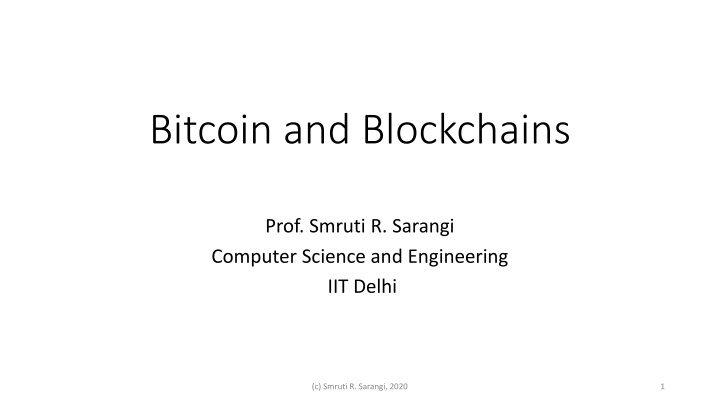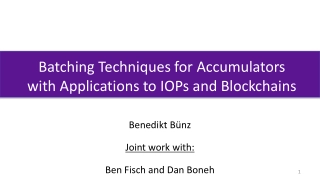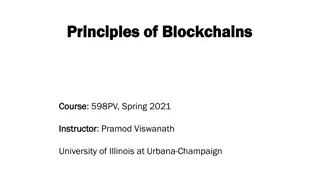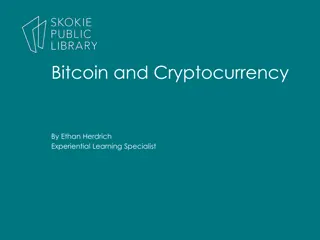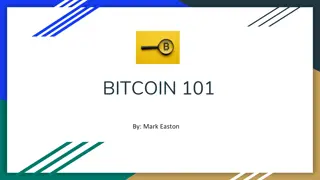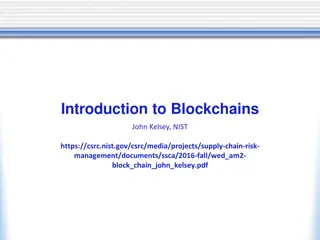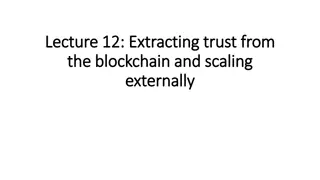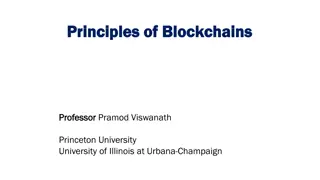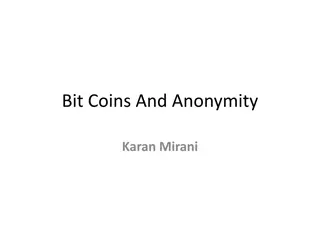Bitcoin, Blockchains, and Cost Functions
In this detailed study by Prof. Smruti R. Sarangi, explore the concepts of Bitcoin, blockchains, and cost functions. Understand the properties of a good cost function, interactive versus non-interactive cost functions, and delve into the intricacies of Hashcash. Discover how tokens are minted, the importance of hash functions, and the exponential relationship between token minting time and specific values.
Download Presentation

Please find below an Image/Link to download the presentation.
The content on the website is provided AS IS for your information and personal use only. It may not be sold, licensed, or shared on other websites without obtaining consent from the author.If you encounter any issues during the download, it is possible that the publisher has removed the file from their server.
You are allowed to download the files provided on this website for personal or commercial use, subject to the condition that they are used lawfully. All files are the property of their respective owners.
The content on the website is provided AS IS for your information and personal use only. It may not be sold, licensed, or shared on other websites without obtaining consent from the author.
E N D
Presentation Transcript
Bitcoin and Blockchains Prof. Smruti R. Sarangi Computer Science and Engineering IIT Delhi (c) Smruti R. Sarangi, 2020 1
Hashcash (c) Smruti R. Sarangi, 2020 2
Cost-functions Definition of a cost-function Easily verifiable Hard to compute The client uses a function ????( ) to create a token, ? The token is sent to the server The server easily checks its value, by calling ?????(?) The token is like money, which has a fixed value The value never changes The more is the value, the more it should take to mint (c) Smruti R. Sarangi, 2020 3
Properties of a Good Cost-function Publicly auditable Anybody can verify its value rather easily A fixed cost-function takes a fixed amount of time to compute A probabilistic cost-function Takes a varying amount of time to compute. The time can either be bounded or unbounded The function should be trapdoor-free Server derives no advantage by minting tokens (c) Smruti R. Sarangi, 2020 4
Interactive and Non-interactive Cost Functions Functions in a non-interactive cost function ? ???? ?,? ?,? are parameters, ? is the token ? ????? ? Functions in an interactive cost function ? ? ?? (?,?) A server issues a challenge to the client ? ???? ? The client mints the token, ?, based on the challenge ? ????? ? (c) Smruti R. Sarangi, 2020 5
Hashcash A non-interactive, publicly auditable, trapdoor-free, and probabilistically unbounded cost-function. Notation Consider a bit string s = {0,1} Let [s]i be the ith bit. [s]1 is the leftmost bit, and [s]s is the rightmost bit. [s]i j is the substring from positions i to j is the string concatenation operator The operator =?compares the first b bits (starting from the left) ? =?? implies ? 1 ? , ??= [?]?, and ??+1 [?]?+1 Let 0k be a very long string of zeros (k is a large number) (c) Smruti R. Sarangi, 2020 6
Hashcash-II ????( ) and ?????( ) functions in the non-interactive variant ? ???? ?,? Find a bit-string x such that ? ? ? =? 0? ? = (?,?) ? ????? ? ? ? ? =? 0? ? is a hash function such as SHA-256, and ? is fairly large (128 bits) Salient points The time it takes to mint a token is exponentially dependent on ? Different tokens have different values of ? (like a number on a note/bill) (c) Smruti R. Sarangi, 2020 7
Interactive Hashcash The problem with the client computing ? is that it can precompute a lot of tokens, or relegate the job to many other nodes. In an interactive system the server sends the challenge ? in this case. The mint and value functions are different in this case ? ? ?? (?,?) Choose a random ? that is k-bits wide ?????? ?,?,? (c) Smruti R. Sarangi, 2020 8
Interactive Hashcash-II ? ???? ? Find a bit-string x such that ? ? ? ? =? 0? ? = (?,?) ? ????? ? ? ? ? ? =? 0? The cost function should be non-parallelizable should not be possible to divide the job of minting the token among a cluster of computing nodes Some variants use modular exponentiation. Reference: [1] (c) Smruti R. Sarangi, 2020 9
Bitcoin and Blockchains (c) Smruti R. Sarangi, 2020 10
Bitcoin Key Ideas Can we create a digital currency? We can then mint money and transfer it between parties to buy services. Let us call them Bitcoins. The main issue is the double-spending problem. Digital currency can be stolen like regular currency, and that too very easily. We need a trusted third party that records each transaction. This is slow and not scalable. Bitcoin solves this problem. Before moving on, study public key encryption, and digital signatures. (c) Smruti R. Sarangi, 2020 11
A chain of hashes Tx Transaction Transaction P1 P2 Transaction P2 P3 Transaction P3 P4 P2 s public key + Tx Details P3 s public key + Tx details P4 s public key + Tx details Previous Transaction Hash Hash Hash Signed with P1 s private key Signed with P2 s private key Signed with P3 s private key (c) Smruti R. Sarangi, 2020 12
Chain of Transactions We create a transaction (P1 P2) with the following elements Hash of the previous transaction. Public key of P2 This establishes the identity of the next element on the chain. Note that processes in bitcoin are anonymous. They are only known by their public key. Details of the transaction: amount of money, time, etc. We compute a hash of these elements. This hash is signed with P1 s digital signature (private key) and stored within the transaction. This means that at a later point in time, P1 cannot say that it hasn t created this transaction (non-repudiation) Other processes can also verify that the transaction is correct and P1 has signed it. (c) Smruti R. Sarangi, 2020 13
Idea of a Distributed Ledger A ledger is a list of transactions organized as a linked list. We simply maintain a list of transactions where we record each and every transaction. The only requirement is that all the nodes agree on the ledger. It does not have multiple versions. The ledger can at any point give us the instantaneous state of the system. Every node has a copy of the ledger. In Bitcoin we use cryptographic mechanisms to establish consensus regarding adding new items to the shared ledger. (c) Smruti R. Sarangi, 2020 14
Double-spending Problem Let us say that using this mechanism Alice transfers some money to Bob At a later point in time Alice, might fork the chain and create another chain of transactions where she diverts the money to a proxy account of her cousin Carlos. Alice Bob This is what happened to Bob Alice Carlos Carlos is Alice s cousin. (c) Smruti R. Sarangi, 2020 15
Notion of a Blockchain It is unwieldy to deal at the level of transactions. The overheads are prohibitive. We thus group transactions into blocks. Transactions can be linked together linearly within a block as we have just seen. More efficient ways exist. We then create a chain of blocks, known as a blockchain. The first block is known as the genesis block. We will still have the same double-spending problem with blocks. Can be solved. [we will see later] In this case we are using it to record Bitcoin transactions. It can be used to record anything that is normally recorded in a ledger or log book. (c) Smruti R. Sarangi, 2020 16
Architecture of the Blockchain Block Block Prev. hash Prev. hash Nonce Nonce Tx Tx Tx Tx Tx Tx Tx Tx Trivial idea: Just group transactions into blocks and chain the blocks. Block i has a hash of block (i-1) to establish the chain. We need to make it hard to generate a block. This will somehow reduce (?) the probability of mounting a double-spending attack. Use proof-of-work (remember Hashcash) (c) Smruti R. Sarangi, 2020 17
Proof-of-work (PoW) We choose a nonce such that: ? ????? ???? ?? ??1 ??2 ??? =? 0? The first n bits of the cumulative hash are all 0s This is a proof of work It takes time to compute such a nonce Just in case the chain gets forked, other nodes will always choose the longest chain This will minimize the probability of a double spending attack Needs to be proven Can be proven that as long as nodes that control a majority of the computing power are honest, the system runs correctly (c) Smruti R. Sarangi, 2020 18
Blockchain Protocol New transactions are broadcast to all the nodes Each node collects transactions sent to it. It checks each transaction, and validates the cryptographic keys. If the transaction is illegal (for some reason), drops it. It groups a set of transactions into blocks (Bitcoin does it once every 10 minutes). Computes a proof-of-work (PoW) Then it broadcasts the block (along with the PoW) to all the nodes Nodes accept the block only if it contains valid transactions and they can verify the PoW. This is where we need to solve a consensus problem: Nodes need to agree to add only one block to the blockchain. In the basic Bitcoin protocol, a node chooses the first block sent to it, and saves other versions of the block, in case it needs to choose a different chain. (c) Smruti R. Sarangi, 2020 19
The Consensus Problem It is possible that different nodes compute different proofs-of-work for the same block. It is further possible that different nodes group different transactions into the next block. Hence, blocks with different versions will be broadcasted in the network. Each of the other nodes save all the versions and choose one of them (first one that they get), and grow the chain. Some localized chain-forking will be seen. Since each node ultimately chooses the longest chain, such forks will die out over time. Note that here consensus is done by purely cryptographic means Known as Nakamoto consensus This is an unpermissioned blockchain Nodes do not know/trust each other. (c) Smruti R. Sarangi, 2020 20
Increasing the Space Efficiency of a Blockchain (c) Smruti R. Sarangi, 2020 21
Incentives What is the incentive for third-party nodes to verify transactions, and create blocks Every creator of a block gets to embed a special transaction at the beginning, paying herself a fixed number of coins. This is known as Bitcoin mining Bitcoin miners get paid (Bitcoin money at first, which can be exchanged for real money in a Bitcoin exchange)! (c) Smruti R. Sarangi, 2020 22
Saving Space Is it necessary to store all past transactions? We can change the format of a block to enable compression later. Block Store the blocks as a Merkle tree The parent contains the hash of its children It is easy to compress this later on. Just get rid of transactions (leaves). The internal nodes anyway contain the hashes. Prev. hash Nonce Root hash H H Tx Tx Tx Tx (c) Smruti R. Sarangi, 2020 23
Combining and Splitting Value To reduce the number of transactions, we typically combine them. We can create a complex multi-input multi-output transaction. Alice s Transaction Money transfer to Bob Previous Txs that credited money to Alice (identified by their hash) Transfer to Alice [Keeping the change] (c) Smruti R. Sarangi, 2020 24
Nakamoto Consensus (c) Smruti R. Sarangi, 2020 25
Analysis of Nakamoto Consensus Alice Bob Alice Carlos Consider the altered sequence of events. Alice waits to add z more blocks before attempting to make an illegal transaction to Carlos. Other nodes have no idea about Alice s intent: Bob or Carlos They simply need to use the longer chain. (c) Smruti R. Sarangi, 2020 26
Probability that a Dishonest Chain will Catch up with an Honest Chain? Attacker is starting at a position that is z blocks behind p probability an honest node adds the next block q probability an attacker adds the next block qz probability that an attacker s chain will catch up, if it starts z blocks behind Using results from the classic Gambler s Ruin problem ??= 1 ?? ? ? ? ? ? ??= ?? ? > ? (c) Smruti R. Sarangi, 2020 27
Analysis - II The attacker s potential progress,?, is given by the following Poisson- distributed random variable ? = z ? ? We can sum up the cumulative probability to find the attacker s probability of success, P (See reference [2]) (c) Smruti R. Sarangi, 2020 28
Probability of the attackers success (P) versus z Very low In Bitcoin, we generate blocks every 10 minutes. We can be sure of a transaction (probabilistically) after 10*z minutes. Typically, z = 6 (total: 1 hour) (c) Smruti R. Sarangi, 2020 29
Hyperledger (c) Smruti R. Sarangi, 2020 30
Hyperledger Framework Collaborative effort to provide a usable blockchain platform. Has several simplifying assumptions It is a permissioned blockchain Nodes join the blockchain after getting prior permission It does not use a proof-of-work based consensus It uses a regular consensus protocol such as RAFT for the consensus operation Smart contract The transaction is an example of a smart contract Most blockchain frameworks allow users to code such smart contracts that the blockchain can technically enforce. (c) Smruti R. Sarangi, 2020 31
References 1. Back, Adam. "Hashcash-a denial of service counter-measure." (2002). 2. Nakamoto, Satoshi. "A peer-to-peer electronic cash system." Bitcoin. URL: https://bitcoin. org/bitcoin. pdf (2008). Cachin, Christian. "Architecture of the hyperledger blockchain fabric." Workshop on distributed cryptocurrencies and consensus ledgers. Vol. 310. 2016. Valenta, Martin, and Philipp Sandner. "Comparison of ethereum, hyperledger fabric and corda.[ebook] Frankfurt School." Blockchain Center (2017). 3. 4. 5. Narayanan, Arvind, et al. "Bitcoin and cryptocurrency technologies." (2015) (c) Smruti R. Sarangi, 2020 32
Thank you (c) Smruti R. Sarangi, 2020 33
